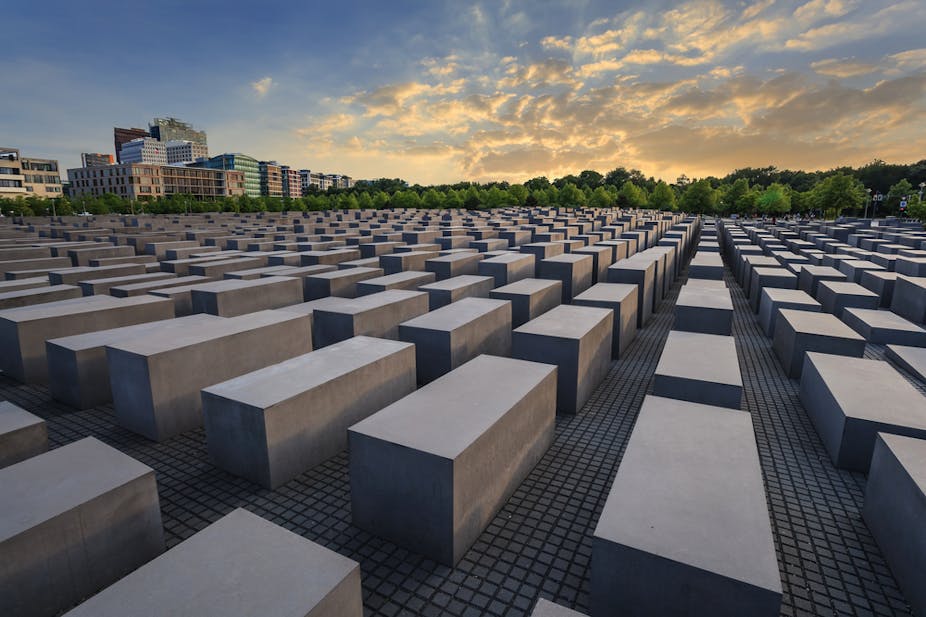On July 7 2005, a series of explosions, unleashed by four terrorists, ripped through London, killing 52 and injuring more than 700 others. It was Britain’s deadliest ever terrorist atrocity.
The 11th anniversary of that atrocity is now just days away and comes shortly after events to mark the 100th anniversary of the battle of the Somme. The 2007 atrocity will be commemorated around the abstract July 7 Memorial in Hyde Park. Designed by Carmody Groarke and opened in 2009, the memorial will be the site of speeches, the laying of wreaths, and respectful silences. But are annual gatherings of this kind enough? Should we congregate around these monuments in remembrance more often, or would the endless replaying of terrible memories from the past stop us from moving forward towards the future?
Monuments of this kind are meant to remain “alive in the minds of future generations”, so we do not forget, so we do not repeat the same mistakes. But our interpretation of the past, as well as the monuments designed to remember them, are under constant change, determined by evolving societies, economics and politics.

In the late 19th and early 20th centuries, remembrance was relatively straightforward: monuments of war offered a powerful visual narrative representing just one side of a conflict – victory. A good example is the Royal Artillery Boer War memorial (1910) in London. The main statue, a female winged figure of peace, is calming a horse representing the spirit of war.
The relief on the base includes images of the army in action, but nothing about the monument refers to the devastation and horror of the Boer War in South Africa. The narrative is selective and its message is clear: the Royal Artillery brought peace to the region. The nuances of the truth are unimportant.
The glorious dead
How war was commemorated changed during the 20th century, as a result of the awful losses of World Wars I and II. Monuments from this period focused on the casualties – in many cases by adding their names to abstract structures, such as the 1919 Cenotaph in Whitehall, London. In many cases, these early 20th-century monuments were updated in the 1940s to add references to the fallen in World War II.
The main shift in commemoration came about in the 1990s, however, as a result of the new political dynamic manifested in momentous events such as the fall of the Berlin Wall, the collapse of communism in Eastern Europe and changes in government in South Africa and several Latin American Countries, such as Argentina and Chile.

There was a new hunger for a broader understanding of the past, including testimonies and points of view which had historically been ignored, even avoided. For example, the Memorial to the Murdered Jews of Europe (AKA the Holocaust Memorial) in Berlin, which opened to the public in 2005, offers a “multidirectional approach to memory” which includes the narrative of the victims of the Holocaust.
The Bebel Platz memorial, meanwhile, commemorates the site of the May 10 1933 Nazi book burning. This monument, designed by Micha Ullman in 1995, is underground – it can be viewed through a window – consisting of empty bookshelves. Even though these examples were designed in a more abstract way than the memorials of the early 20th century, they still make vivid connections with the past, illustrated by the evocative empty library of the Bebel memorial or the cemetery-like structure of the Holocaust monument.
Informal connections
The abstract aspect of the Holocaust Memorial in Berlin, together with its location in the city, has brought about a less formal interaction with it. It is used as a public space, where people interact and even play – games of hide and seek, or jumping from one stellae to the next are common pastimes here. There are, however, rules. On the ground you can find instructions on how people are expected to behave around it – loud noises, pets, bicycles and alcohol are prohibited.

The Memory Park in Buenos Aires, which marks those “disappeared” during the country’s military dictatorship, not only offers a site for remembrance, but also encourages other activities. Music, dance, theatre and arts workshops are commonplace.
The abstract representation of conflict, war, terrorism and violence begs an important question: to what extent do the public comprehend the message of these structures? Would it be better to go back to a more descriptive approach, such as the narrative one used at the beginning of the 20th century?
In the United Kingdom, new war memorials now are concentrated in one location: the National Memorial Arboretum. The 150-acre site includes more than 320 memorials, representing military associations, charitable organisations, emergency services, fraternity groups and individuals. The most significant and iconic structure is the Armed Forces Memorial, which sits on top of a hill and commemorates veterans who have fallen in conflicts from 1945 (Palestine) until the present, including the Balkans, Afghanistan, Iraq and Libya. Their names are engraved on the main walls of the monument, as a tribute to their lives, as a reminder of the human cost of these wars.

However, it seems as if this space has a very specific audience, who are often connected somehow to the armed forces. It is initiatives such as the Tower of London Remembers event, in November 2014, that has a more powerful engagement with the general public.
During this, 19,000 volunteers helped to install 888,246 ceramic poppies in the moat at the Tower of London, a transitory memorial visited by more than 5m people. Indeed, memories are best reinforced through the creation of new memories. As such, it is important that we all become part of acts of commemoration, to entwine our own memories with those of our predecessors – and to become a part of our shared history.

